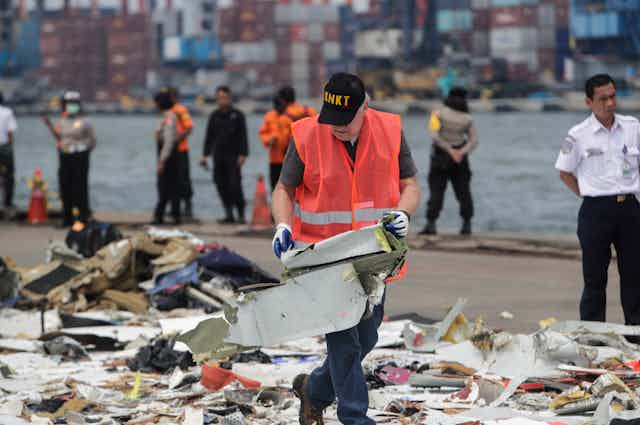Indonesian divers last week retrieved a “black box” recorder from the sunken wreckage of Lion Air passenger jet JT-610 that crashed into the sea on Monday, killing all 189 people on board.
Reports say the search and rescue team retrieved the flight data recorder, one of two recorders required for every commercial airliner. The other is the cockpit voice recorder.
Flight data recorder and cockpit voice recorder can reveal a wealth of information about the flight. Depending on the type, modern digital flight data recorders can capture more than 2000 parameters, giving investigators a thorough insight into what the various systems of the aircraft were doing and what configuration the aircraft was in leading up to the crash.
What black boxes reveal
Air safety investigation is an exacting science. It is based on proven, systematic methods of investigation and analyses, where conclusions are based on the available evidence. The investigators of JT610 will explore many aspects of Lion Air’s operations, looking for contributing factors.
The recorders will inform investigators of any warnings and alarms went off in the cockpit, and what the crew’s responses to those were. They will also reveal any control inputs were made, what effect they had, all the cockpit switch positions, and a wealth of other relevant information.
The flight recorders may give a clear indication of what systems malfunctioned and what the crew responses to those were.
Finding out the why
However, the flight data may only shed light on what happened. Investigators must systematically investigate other evidence to be sure why it happened. Investigators will also analyse the airline’s maintenance records, the flight crew training regime and records, aircraft loading systems and documentation, passenger records and air traffic control recordings, for example.

Specialist investigators will also look into aspects of the aircraft’s instrumentation, avionics (the electronics fitted in an aircraft), engines, airframe (the body of the airplane), electrical systems, hydraulic systems, as well as human factors and crew performance. It will all be thoroughly analysed before any final conclusions will be drawn.
No doubt, a major part of the investigation will be to answer the question of how a sophisticated new aircraft, with multiple redundancies of all its critical systems, could apparently experience a catastrophic sequence of failures that led to it crashing. The experience of the previous flight suggests there could have been a problem with the aircraft’s pitot static system that provides static and dynamic air pressure to the primary flight instruments. Although that fault was apparently rectified before the fateful flight, it may have re-appeared or worsened during or after take-off.
If investigators of JT610 found that a malfunction of the pitot static system did occur, other questions will be raised about why the crew could not cope with that malfunction. Airliners have for years been designed with separate static air systems for the captain’s and first officer’s instruments. Theoretically a failure should not be able to adversely affect instrumentation on both sides of the cockpit.
Also, the pilots should have been able to select the alternate static air source, to recover effective static air for any affected instruments. On top of all that, the aircraft would have been fitted with a “standby” artificial horizon, airspeed indicator, altimeter and compass, so that the crew should have had the minimum of flight instrumentation, independent of all the other systems, to allow them to safely fly the aircraft back to the airport.
In that circumstance, the pilots would be flying the Boeing 737 with the same level of instrumentation as if it were a basic single engine light aircraft.
If that all proved to be the case, then the focus would move to the standard of Lion Air’s pilot checking and training, simulator training methods and sequences. Had these pilots ever been confronted with partial or full instrumentation failures in the simulator? Had they ever attempted to fly the simulator solely on the standby instruments, and if they had, how did they perform in those circumstances?
This would in turn lead to questions about the airline’s flight standards, crew resourcing policies, corporate governance arrangements, management decision-making and operational safety culture, and a whole lot more.
I’ve no doubt the investigators of JT-610 will systematically reveal what took place and why. I am equally sure there will be many causal factors revealed that led to the tragedy. Ultimately we will learn the lessons, so the victims will not have been lost and their loved ones suffered in vain.


